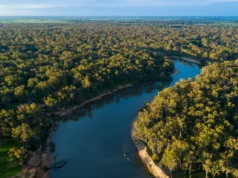
If you’re in any doubt that autumn colours can inspire poetry, look no further than the names we give to deciduous trees. Sweet gum’s botanic name is Liquidambar (for the colour of its sap) and it comes from the witch-hazel family (for its magical colour-changing, perhaps?). Ahead, discover a quartet of seasonal spots to observe the landscape ignite in shades of ochre, burnt orange and rich rust. These are the best places to see the leaves change in autumn…
Adelaide Hills
Autumn in the Adelaide Hills brings out painters as well as poets, and many find their muse at Mount Lofty Botanic Gardens, where the rusting trees crane for a view over the glassy lake, hillsides a splotched palette of turmeric yellow and rufous red. The hills are also alive with cultural colour. Stirling Laneways Market runs on the fourth Sunday of the month until May 22, and the tree-lined towns of Aldgate, Hahndorf, Bridgewater and Mylor are flush with galleries, artisan makers, restaurants, wineries (take a drive through Piccadilly Valley) and craft breweries, where you can sample a different sort of liquid amber.
Mount Field, TAS
Pedants enjoy pointing out that the “turning of the fagus”, when Tasmania’s native “tanglefoot” trees take on autumnal shades, is woefully misnamed. Fagus means “beech”, and these stunted specimens that colour so much of Tasmania’s mountain areas are not technically beeches. The clue is in the Latin name, Nothofagus gunnii (think: “not a fagus”). Whatever you call it, the annual spectacle from this Gondwanan relic is immense, with a carpet of colour laid across the cool tones of the alpine wilderness. Reward is contingent on effort, so pack the hiking shoes for the 12km round-trip to the Tarn Shelf to see the trees rusting orange round the fringes of deep glacial lakes. The shores of Lake Fenton offer a shorter walking option, and you can even see the show from Lake Dobson Rd without leaving your car. “The turning” traditionally kicks off around Anzac Day.
Blue Mountains Botanic Gardens
Mount Tomah in the Blue Mountains is a maple heartland, with nearly 200 varieties vying for attention inside the UNESCO World Heritage Area gardens. The extensive grounds are home to the critically endangered Cloud Forest Sugar Maple (native to Mexico) and the Chinese maple (Acer pentaphyllum), of which fewer than 500 remain. More than half the specimens here are Japanese maples, including the ancient cultivar Aka shigitatsu sawa, loosely translating as “Snipes take flight from a marsh”. While water birds are rare, you’ll likely see king parrots and crimson rosellas competing for brilliance among the multi-coloured foliage. The leaves are already starting to turn, and are normally at their peak around late April.
Walhalla, VIC
A ribbon of colour curls like a blood-red stream through this steep-sided valley. The tiny Gippsland town of Walhalla was founded on gold in the 1860s, and after nearly falling off the map has found new veins, thanks to a different type of digging. More than 200 deciduous trees were planted by locals after the Black Saturday bushfires of 2009 to rejuvenate tourism and complement the “Europeanness” of the compact township. Ornamental pears, birches, poplars, smoke bush and maples give a strip of concentrated colour along the main road that winds up the valley floor. Money for the project was raised through people sponsoring trees, and strategic use of the colour wheel achieved eye-catching contrasts. Yellows and oranges were largely eschewed in favour of colours that would pop against the backdrop of the
blue/green eucalyptus hillsides. The bright red lipstick maples in full blush outside the bricks of historic Windsor House are a stunning exemplar.
Read the story here


